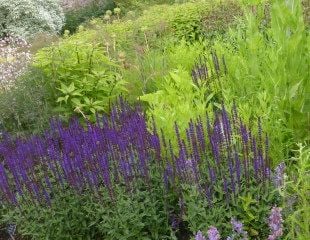


How to Grow Salvia
The Salvias which we commonly grow in our gardens, tend to be herbaceous perennials and evergreen varieties. For best results and flowering, grow Salvia in a sunny position, on light, sandy, well-drained soil. Salvia grown in soil which is too rich, or in dappled shade is inclined to be leggy with fewer flowers.
Salvia varieties vary in their hardiness, although all will tolerate degrees of cold. Some Salvia are H3 hardy, which is only Hardy in some mild parts of the UK, other varieties S. nemorosa and Salvia x sylvestris are H5 Hardy down to -15. However, none of the Salvia varieties will grow in wet, boggy soil, which means they are not an ideal choice for clay soil. Salvia will tolerate cold weather better if they are growing in well-drained soil or in a container. The evergreen varieties are best left with the foliage in place over winter to provide some winter protection. The more tender varieties will benefit from a winter mulch.
Salvia patens 'Cambridge Blue' illustrated above left is a fantastic strong blue, but as H3 it will need a sheltered planting spot.
During the flowering period, dead heading the flowers or removing the flower spikes will prolong flowering. Cut back Salvia in the spring when the fresh shoots appear.
Plant Salvia in an area of the garden which is dry and with a good amount of sunshine. The leaves and plants are often aromatic, making them attractive to bees. Salvia is not suitable if the growing conditions tend to be wet, (and cold,) especially over the winter. I planted a group in my garden in the North of England, which was always wet over the winter, and they never reappeared in the spring. Like so many plants from warmer climates, Salvia will not tolerate both cold and wet over winter.
Illustrated above are some of the most popular and widely available varieties available and typical garden types of Salvia.
Salvias also look great in a mixed border and are good companion plants to many of our popular garden plants.
You can grow Salvias in containers. Many Salvias such as Salvia nemorosa and Salvia x sylvestris are fully hardy to -10-15 H5 hardy. Because they are so very hardy, Salvia will do well in containers and the drier environment will suit.
Types of Salvia for the garden
Far left is Salvia patens 'Cambridge Blue' a lovely shade of blue and this variety has the RHS garden merit award, always a good indicator when selecting a plant to grow. This Salvia grows to about 75 cms and is a great addition to a sheltered border. It is H3 hardy, which means only down to -5 and so may need winter protection.
The centre image is a more upright Salvia, which is a strong, almost iridescent blue, Salvia × sylvestris 'Mainacht' very attractive to bees and it will tolerate light and limited dappled shade. If cut back after the first flowering, it may produce a smaller second flush in late summer. Removing the flower spikes will keep the plant flowering.
Illustrated far right is the aptly name Salvia 'Hot Lips' fully hardy down to -10 and which grows up to 1m.
In the same group is the common sage, which is grown as a culinary herb, (ideal with pork and sausages.) Sage makes a nice border plant in its own right, separate from its culinary uses. It has attractive soft, grey-green leaves and a low growing compact habit. You can cut back sage if it outgrows its space or spills onto a path; it responds well even to hard pruning. It is a perennial evergreen growing to around 45-60 cms (1.5-2 ft tall) Common sage is good in a border if you want to add some green as an alternative to Hostas.
There are a number of tender, annual varieties which are often grown as summer bedding, including the ubiquitous Salvia spendens, a scarlet variety familiar beddding plant.

In most parts of the UK, Salvia is hardy and easy to grow. Select a variety with a H rating suitable for your garden and plant in a sunny spot and in well-drained soil.
